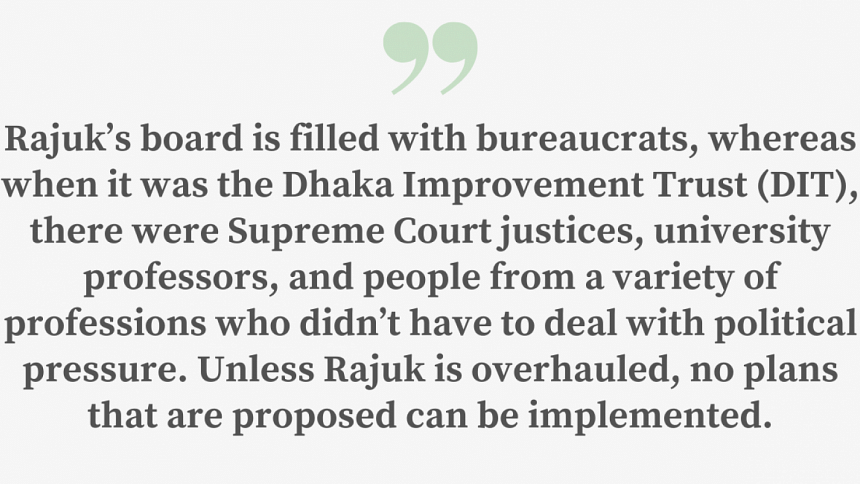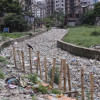New DAP has too many loopholes

A section of the Town Improvement Act, 1953 stipulates that when a Detailed Area Plan (DAP) for Dhaka is formulated, it should be made available to the public as a gazette and public opinion on it must be heard. When it came to the latest DAP (2022-35), people as well as professional organisations (such as ours) provided a lot of feedback. But the DAP that has finally been published seems to have zero reflection of that feedback.
There is no way to tell what the general people's feedback was regarding the new DAP, and how much of it Rajuk took into account. We're not saying that Rajuk didn't survey the public, but we don't know if they took that public feedback into account, or if they implemented any feedback that didn't serve their own agenda.
There's no way to call this a "people's DAP." It does mention some goals, but without sketching out a plan to achieve them. For example, there are mentions of separate pedestrian paths, bicycle paths, and aquatic parks, but there are no specific plans for them.
Two aspects of this DAP are being discussed heavily. One aspect includes water reservoirs, forestry, and agricultural land, and the other includes floor-area ratio (FAR).
According to the FAR mentioned in the DAP, 350 people will live in every square kilometre. This is quite high by global standards, but our reality is that we are the most densely populated capital in the world, so maintaining global standards here will not be possible. To present an idea of how much they want to compromise with the global standards: some areas, where one might say powerful people are developing housing projects, have been given a higher FAR. In other areas, where those with less influence reside, a lower FAR has been assigned.
They are saying that if a higher FAR is assigned to those areas, a landlord may rent out multiple floors for commercial activities. We don't think this is a matter of business but a matter of people's livelihood. Another question that arises is, if a person has lived in a building with a high FAR until now, should they no longer live in Dhaka because the FAR for their building has been lowered? Will they live somewhere else? This needs to be clearly communicated. The government needs to provide a solution for this.

When the draft DAP was announced, two housing projects were given a lower FAR. But in the final DAP, their FAR was increased with the reasoning that they would build roads and make the area suitable. Well, for those who can't make it suitable, it's the government's responsibility to build the roads. You can't hold off investment and assume that lowering the FAR would lead to less population density.
Moving on to water reservoirs, since the 2010 DAP was passed, 45 percent of water reservoirs in many areas of the city were filled up by 2019. The government had passed an act in 2000 to prevent filling up water reservoirs, to punish those who had already done so, and to return water reservoirs to their previous state. The act states that water reservoirs include rivers, drains, canals, marshes, and "flood flow areas" that will be specified in a master plan.
Now, Rajuk has been referring to this DAP as the master plan, but no flood flow areas have been identified in it. They are saying it is not a separate area at all – it has to be viewed as a part of the main floodplain. By doing this, they are diluting the debate; they are saying that they will categorise water reservoirs into general water reservoirs and main water reservoirs. General water reservoirs can be filled upon approval, but main water reservoirs may not be filled.
In that case, how did Rajuk approve the Jolshiri Abashon project when it was developed by filling up a main water reservoir? In response, they say they had a survey done by Buet on the water flow in the area. So, instead of blocking a project that fills a main water reservoir, Rajuk simply made Buet conduct a study and then made arrangements to approve the project, caving to the influence of powerful people.
In another case, Rajuk is referring to a flood flow area in Ashulia as a general water reservoir to implement another housing project called Lake City. On the one hand, the city development authorities won't increase FAR because density will go up, but then they will create townships by filling up general water reservoirs, setting precedence for others. This way, it will be difficult to protect the water reservoirs in and around Dhaka.
The small number of water reservoirs that remain today cannot be allowed to get filled up. Not only are they important for Dhaka's drainage, but they also serve agricultural and fishery purposes, and are also a source of food. They also replenish groundwater, which is an essential factor to consider.
We wish to know how many campaigns Rajuk has taken up against illegally possessed land on water reservoirs, how many people have been punished, how many cases they have lodged, how many times they have taken this issue to court, and how many times they have involved the Office of the Attorney General.
Rajuk has always cowered before groups with vested interests. A big reason behind this is that they are not held accountable for their activities. When they say that more than 80 percent of all buildings in Dhaka have been built without approval, it's clear that they have no interest in regulations. When they developed Phase 2 of Purbachal city, they paid Tk 12 crore as compensation for land and Tk 15 crore for trees. They claim to have preserved a forest there, but they would not have done so unless the High Court had intervened, after we took the issue to the court. If Rajuk had only developed one-third of the area and left two-thirds to greenery, developing the project vertically, our problems wouldn't have been so extreme.
It's time for a Rajuk reform. Rajuk's board is filled with bureaucrats, whereas when it was the Dhaka Improvement Trust (DIT), there were Supreme Court justices, university professors, and people from a variety of professions who didn't have to deal with political pressure. Unless Rajuk is overhauled, no plans that are proposed can be implemented.
The new DAP has made many proposals that sound great, but that have not been backed up by action plans. It does not provide any vision. This DAP is in conflict with regulations regarding water reservoirs; the FAR mentioned in this plan is in conflict with the building construction code. This DAP or any plan whatsoever cannot be implemented in Dhaka until Rajuk is reformed and their transparency and accountability is ensured.
Rajuk has to become a vibrant, evolving institution. It has to face and overcome challenges as they present themselves. Although Rajuk has some plans for slum residents in this DAP, we have heard of similar plans in the past, which were not implemented. It won't be too far-fetched to say that Rajuk has failed to ensure equality in its current planning.
Syeda Rizwana Hasan, a Supreme Court lawyer, is the chief executive of Bangladesh Environmental Lawyers Association (BELA).
Transcribed and translated by Azmin Azran.

 For all latest news, follow The Daily Star's Google News channel.
For all latest news, follow The Daily Star's Google News channel. 












Comments